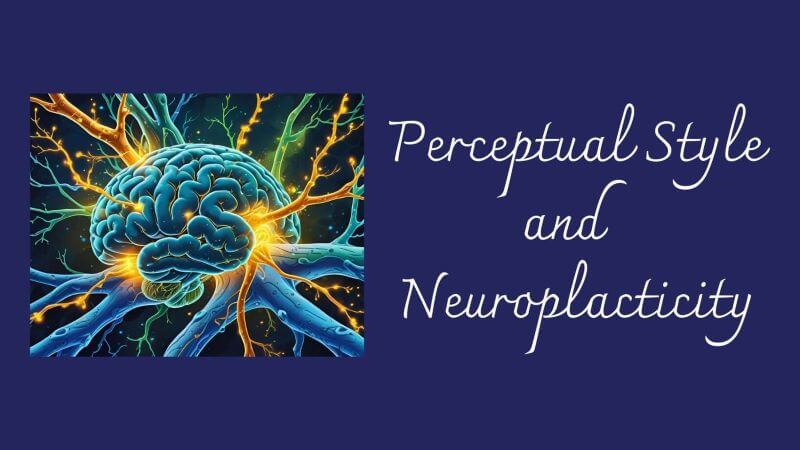Can We Rewire How We See the World?

 The brain is a marvel of adaptability. Thanks to neuroplasticity — the brain’s ability to reorganize itself by forming new neural connections — we now know that meaningful growth and change are possible well beyond childhood.
The brain is a marvel of adaptability. Thanks to neuroplasticity — the brain’s ability to reorganize itself by forming new neural connections — we now know that meaningful growth and change are possible well beyond childhood.
Habits can shift. Reactions can soften. New ways of thinking, feeling, and engaging with others can emerge — not overnight, but absolutely over time.
But that raises an intriguing question: Can we change how we perceive the world?
Can we rewire the very lens through which we interpret reality?
To answer that, we need to explore how Perceptual Style™ relates to neuroplasticity — and where the limits of change meet the possibilities of transformation.
What Is Perceptual Style?
Perceptual Style refers to the consistent, natural way you take in, organize, and make sense of information from the world around you. It shapes:
-
What you notice
-
What you prioritize
-
How you interpret meaning
-
How you relate to others
Perceptual Style is not about behavior — it’s about the filter behind the behavior.
According to Perceptual Style Theory™ (PST), your style is innate, much like your dominant hand or eye.
It’s not chosen or developed through environment, but rather reflects a cognitive orientation that feels “right” and instinctive to you.
What Is Neuroplasticity?
Neuroplasticity is the brain’s remarkable ability to change throughout life.
It’s how we recover from injury, form new habits, acquire knowledge, and adapt to new environments.
There are two types of neuroplasticity:
-
Functional plasticity: the brain’s ability to shift functions from damaged areas to undamaged areas.
-
Structural plasticity: the brain’s capacity to physically change its structure in response to learning, experience, and memory.
This adaptability fuels personal growth and learning. It explains why you can develop emotional intelligence, change your reactions to stress, or build new perspectives through therapy or mindfulness.
Can Perceptual Style Be Rewired?
Here’s the subtle but important distinction: Perceptual Style itself does not change — but what you do with it can.
Think of it like this: Your perceptual style is the operating system. It governs how information is received and processed. Neuroplasticity allows you to add apps, change settings, build skills, and expand range — but the core operating system remains the same.
Here’s what can change. You can:
-
Learn to recognize your own perceptual biases and blind spots.
-
Develop appreciation for how others perceive differently.
-
Build neural flexibility in how you respond to what you perceive.
-
Choose new interpretations or meanings, even if your perceptual filter remains constant.
This is what doesn’t change:
-
Your innate perceptual orientation — the way your brain is naturally wired to organize information.
-
The kind of information you instinctively notice first or find most meaningful.
The Power of Awareness & Plasticity
When you combine self-awareness (through Perceptual Style) with neural adaptability (through neuroplasticity), powerful personal growth becomes possible.
For example:
-
A person with a Perceptual Style that favors action and immediate outcomes may, through awareness and effort, learn to pause and consider emotional implications—without losing their core orientation.
-
Someone wired to see patterns and systems might learn to stay present with people’s emotions, expanding their relational skills without abandoning their natural analytical strength.
Neuroplasticity doesn’t overwrite who you are — it builds flexibility within your existing perceptual framework.
Why This Matters
If you’ve ever felt frustrated by recurring emotional patterns, reactive habits, or interpersonal misfires, you’re not alone. Many of these challenges stem from unconscious perception — automatic ways of interpreting the world that go unexamined.
Understanding your Perceptual Style is the first step. It reveals your strengths, your defaults, and your blind spots.
Neuroplasticity gives you the tools to grow beyond those blind spots, without needing to change your core self.
This integrated approach leads to:
-
Better emotional regulation
-
Deeper empathy
-
More effective communication;
-
Lasting personal transformation
Final Thought: Expand Without Erasing
You can’t change your Perceptual Style — and you don’t need to. It’s not a limitation; it’s a foundation.
The goal isn’t to “rewire” who you are but to expand your capacity to respond, relate, and adapt from a place of conscious awareness.
When perception meets plasticity, real growth begins — not by becoming someone else, but by becoming more fully yourself.
Please share your thoughts on this topic in the comment section below.
Explore the services that we provide to support the success you want and deserve!
© Vega Behavioral Consulting, Ltd., All Rights Reserved
About Dr. Gary M. Jordan, Ph.D.
Gary Jordan, Ph.D., has over 35 years of experience in clinical psychology, behavioral assessment, individual development, and coaching. He earned his doctorate in Clinical Psychology from the California School of Professional Psychology – Berkeley. He is co-creator of Perceptual Style Theory, a revolutionary psychological assessment system that teaches people how to unleash their deepest potentials for success. He’s a partner at Vega Behavioral Consulting, Ltd., a consulting firm that specializes in helping people discover their true skills and talents.
Meet Dr. Jordan — Learn about his background and contributions to the Perceptual Style Theory